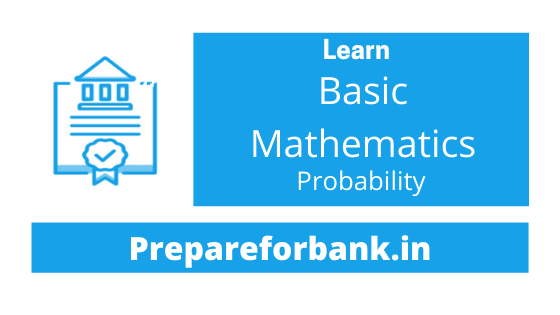Probability equations are an important topic to be covered in competitive exam preparation be it for IBPS Clerk, PO, RRB, SO, or SBI Clerk or PO Exams. The number of Probability equations questions and the complexity of vary from exam to exam every year.
Questions on Probability Equations are complex in nature and require an understanding of Average, and Math Tables. Example questions on Probability Equations and practice questions on Probability Equations are given in this article.
Nowadays, questions in exams are mixed with multiple concepts and it requires practice and a deep understanding of basic concepts along with quickly identifying numbers.

Table of Contents
What is Probability?
Probability is another word used to show a calculated guess or possibility of anything happening. In our day-to-day life, we come across many such scenarios where we have to guess or we’re not sure. The amount of uncertainty will help in guessing, or the surety of that event to happen.
Although the use of probability started with gambling, it has now been used extensively in many fields like Physical Sciences, Commerce, Weather Forecasting, Biological Sciences, Medical Sciences, etc.
Let’s understand Probability with the help of an example, if we’ve to toss a coin then the chance of getting head in toss is called Probability. The event of tossing the coin is called a ‘Trial‘.
Based on what we directly observe as the outcomes of our trials, we find the experimental or empirical probability. Let ‘n’ be the total number of trials. The empirical probability P(E) of an event E happening, is given by:
P(E) = Number of Successful Trials in the Event / Total Number of Trails
Solved Examples of Probability Equations
Below are a few solved examples of Probability:
Example 1: A coin is tossed 100 times with the following results:
Head: 45, Tail: 55. Find the probability for each event?
Solution 1: As per the question we need to find the probability for each event. So in the toss of a coin, there can be two possible events: (1) Heads and (2) Tails.
Probability of Head => P(E) = Number of Heads / Total Number of Toss
=> P(E) = 45 / 100 = 0.45
Probability of Tail => P(E) = Number of Tails / Total Number of Toss
=> P(E) = 55 / 100 = 0.55
Example 2: Two coins are tossed simultaneously 50 times, and we get the below results:
Two Heads: 10 Times
One Head: 27 Times
No Heads: 13 Times
Find the probability of each of these events?
Solution 2: As per the question there are three events for which we need to find probabilities:
Probability of Two Heads => P(E) = Number of Two Heads / Total Number of Toss => P(E) = 10 / 50 = 0.2
Probability of One Head => P(E) = Number of One Head/ Total Number of Toss => P(E) = 27 / 50 = 0.54
Probability of No Heads => P(E) = Number of No Heads / Total Number of Toss => P(E) = 13 / 50 = 0.26
To cross verify result we can sum up all the Probable events and it should result in 1. => 0.2 + 0.54 + 0.26 = 1
Example 3: A box contains 3 Blue, 2 White, and 4 Red Balls. If a ball is drawn at random from the box, what is the probability that it will be: Red, White, and Blue?
Solution 3: Total Number of Balls = 3 + 2 +4 = 9 Balls.
Probability of Red Ball => P(E) = Number of Red Ball / Total Number of Balls => P(R) = 4 / 9 = 0.44
Probability of White Ball => P(E) = Number of White Ball / Total Number of Balls => P(W) = 2 / 9 = 0.22
Probability of Blue Ball => P(E) = Number of Blue Ball / Total Number of Balls => P(B) = 3 / 9 = 0.33
Practice Probability Equations Questions
Below are a few Practice Probability Questions:
- A coin is tossed 1000 times with the following results: Head: 377, Tail: 623. Find the probability for each event?
- Two coins are tossed simultaneously 50 times, and we get the below results: Two Heads: 20 Times, One Head: 14 Times, No Heads: 16 Times. Find the probability of each of these events?
- A bag contains 3 red balls and 5 black balls. A ball is drawn at random from the bag. What is the probability that the ball drawn is (i) Red? (ii) not Red?
- A box contains 8 Blue, 12 White, and 10 Red Balls. If a ball is drawn at random from the box, what is the probability that it will be: (I) Red? (ii) White? (iii) Blue?
- A box consists of 100 shirts of which 86 are good, 8 have minor defects and 6 have major defects. A trader will only reject the shirts which have major defects. Find the probability of shirts acceptable to traders?
Final Words
Practicing the above Probability Equations questions is not the end of your practice, but it’s the start of a new journey to apply logic to Probability Equations Questions with multiple approaches in a right and faster way.
For cracking competitive exams one must practice Probability Equations Questions without a calculator is a must. At last, during the exam, if a solution for the Probability Equations Questions cannot be found easily then mark that question to revisit and move ahead instead of wasting time and energy.
